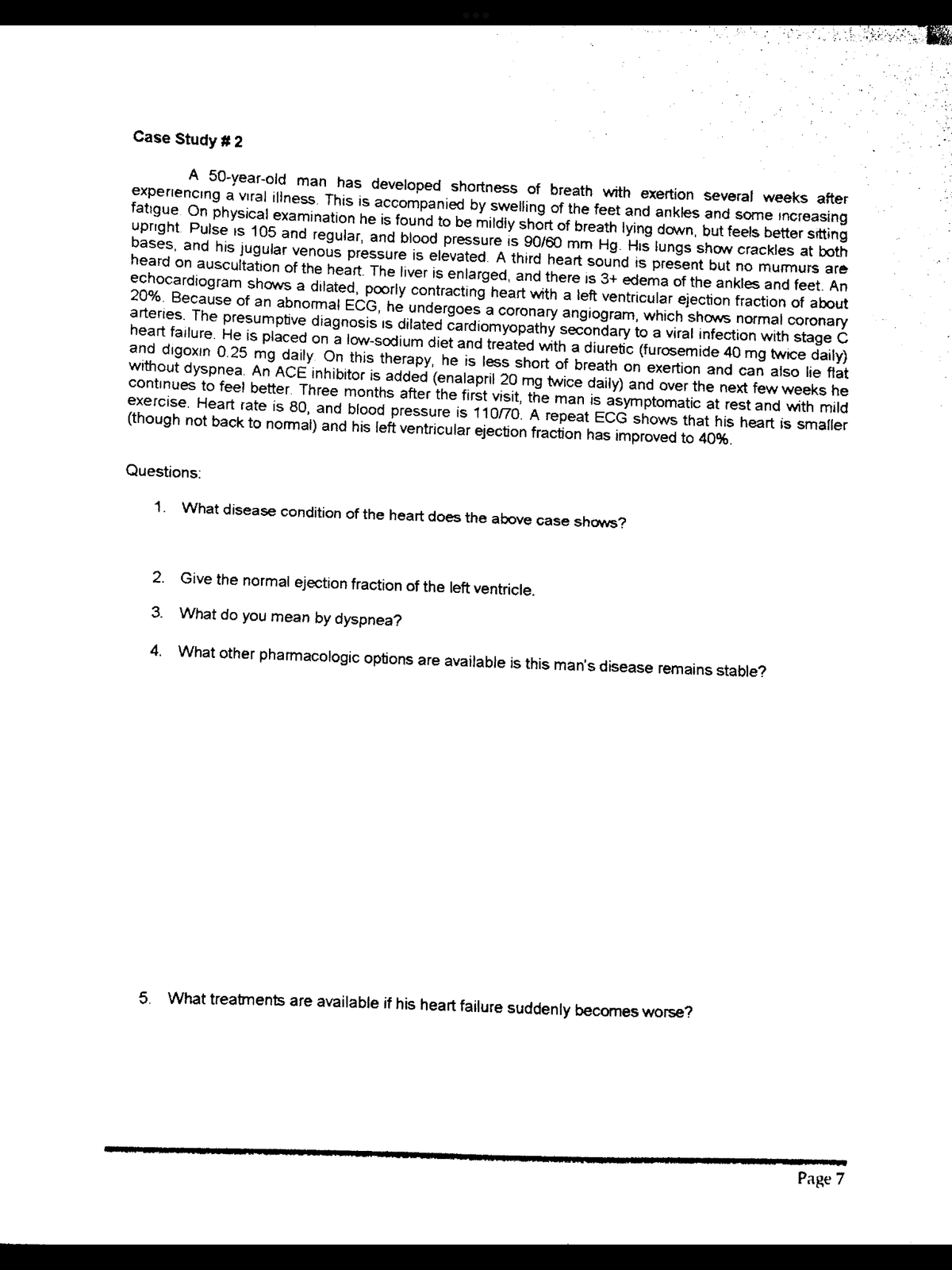Questions: 1. What disease condition of the heart does the above case shows? 2. Give the normal ejection fraction of the left ventricle. What do you mean by dyspnea? 4. What other pharmacologic options are available is this man's disease remains stable?
Questions: 1. What disease condition of the heart does the above case shows? 2. Give the normal ejection fraction of the left ventricle. What do you mean by dyspnea? 4. What other pharmacologic options are available is this man's disease remains stable?
Surgical Tech For Surgical Tech Pos Care
5th Edition
ISBN:9781337648868
Author:Association
Publisher:Association
Chapter17: Otorhinolaryngologic Surgery
Section: Chapter Questions
Problem 17.3CS
Related questions
Question

Transcribed Image Text:Case Study # 2
A 50-year-old man has developed shortness of breath with exertion several weeks after
experiencing a viral iliness. This is accompanied by swelling of the feet and ankles and some increasing
fatigue. On physical examination he is found to be mildiy short of breath lying down, but feels better sitting
upright. Pulse is 105 and regular, and blood pressure is 90/60 mm Hg. His lungs show crackles at both
bases, and his jugular venous pressure is elevated. A third heart sound is present but no mumurs are
heard on auscultation of the heart. The liver is enlarged, and there is 3+ edema of the ankles and feet. An
echocardiogram shows a dilated, poorly contracting heart with a left ventricular ejection fraction of about
20%. Because of an abnormal ECG, he undergoes a coronary angiogram, which shows normal coronary
arteries. The presumptive diagnosis is dilated cardiomyopathy secondary to a viral infection with stage C
heart failure. He is placed on a low-sodium diet and treated with a diuretic (furosemide 40 mg twice daily)
and digoxin 0.25 mg daily. On this therapy, he is less short of breath on exertion and can aiso lie flat
without dyspnea. An ACE inhibitor is added (enalapril 20 mg twice daily) and over the next few weeks he
continues to feel better. Three months after the first visit, the man is asymptomatic at rest and with mild
exercise. Heart rate is 80, and blood pressure is 110/70. A repeat ECG shows that his heart is smaller
(though not back to nomal) and his left ventricular ejection fraction has improved to 40%.
Questions:
1.
What disease condition of the heart does the above case shows?
2. Give the normal ejection fraction of the left ventricle.
3. What do you mean by dyspnea?
4.
What other pharmacologic options are available is this man's disease remains stable?
5.
What treatments are available if his heart failure suddenly becomes worse?
Page 7
Expert Solution
This question has been solved!
Explore an expertly crafted, step-by-step solution for a thorough understanding of key concepts.
Step by step
Solved in 2 steps

Recommended textbooks for you

Surgical Tech For Surgical Tech Pos Care
Health & Nutrition
ISBN:
9781337648868
Author:
Association
Publisher:
Cengage

Basic Clinical Lab Competencies for Respiratory C…
Nursing
ISBN:
9781285244662
Author:
White
Publisher:
Cengage

Surgical Tech For Surgical Tech Pos Care
Health & Nutrition
ISBN:
9781337648868
Author:
Association
Publisher:
Cengage

Basic Clinical Lab Competencies for Respiratory C…
Nursing
ISBN:
9781285244662
Author:
White
Publisher:
Cengage